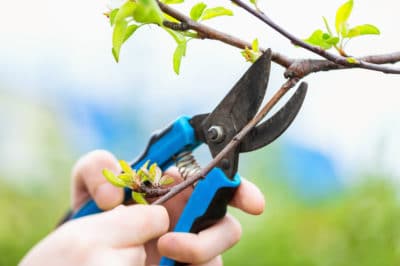Why Pruning Cherry Trees is Important
Pruning cherry trees is an important part of their general care, and there are several reasons for this:
- Pruning cherry trees builds a strong and sound structure of branches which can support the load of fruit.
- Proper pruning spurs the growth of fruit wood, leading to a more abundant harvest.
- Pruning opens up the interior of the tree, providing more light to the leaves and better air circulation, resulting in more vigorous growth and less damaged fruit.
- Removal of dead, damaged, and crossing branches keeps the tree healthy and productive.
- Pruning limits the height of the tree, making harvesting of fruit easier.
When to Prune Cherry Trees for Best Results
Pruning removes and shortens branches from the tree by cutting them out with a pair of shears. When first done, a pruning cut is susceptible to infection by fungal and bacterial diseases.
Cherry trees are especially susceptible to diseases, so it is best to prune them in summer after you harvest fruit. If your trees are still too young to produce fruit, wait until July to prune them.
How to Prune Cherry Trees
The most important concept to understand when pruning any fruit tree is the difference between a thinning cut and a heading cut. Thinning cuts remove branches and limit growth. Heading cuts do just the opposite: They cut back branches in a way which spurs the growth of leaves and fruiting wood.
The first year after you plant a young cherry tree, thin the central, leading branch and leave three or four sturdy branches growing around the main trunk outward at an angle. This early pruning establishes the basic shape of the tree with a vase-like structure.
In the next two years, before the tree begins fruiting, prune lightly, removing dead, damaged, and crossing branches and heading back strong branches one third of their length to spur fruit-bearing wood. Cherries bear blossoms and fruit on wood which is two years old or older, so during this period, you want to encourage the growth of fruit wood with heading cuts.
As the tree matures and starts bearing fruit, prune your cherry tree to remove old, unproductive fruit wood. Most of the pruning cuts on an older cherry tree are thinning cuts, rather than heading cuts.
